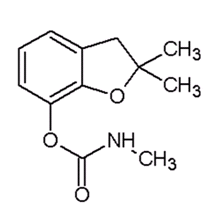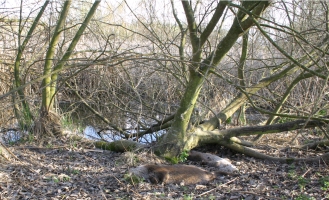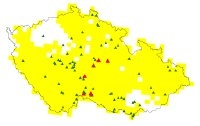IUCN/SSC Otter Specialist Group Bulletin

|
IUCN/SCC Otter Specialist Group Bulletin Volume 27 Issue 3 Pages 123- 166 (December 2010)) Citation: Poledníková, K., Větrovcová, J,, Poledník, L and Hlaváč V. (2010). Carbofuran - A New and Effective Method of Illegal Killing of Otters (Lutra lutra) in the Czech Republic . IUCN Otter Spec. Group Bull. 27 (3): 137 - 146 Carbofuran - A New and Effective Method of Illegal Killing of Otters (Lutra lutra) in the Czech Republic Kateřina Poledníková1, Jitka Větrovcová2, Lukáš Poledník3, Václav Hlaváč4
1
ALKA Wildlife, o.p.s., Lidéřovice 62, 38001 Dačice, Czech Republic. e-mail: katerina.polednikova@alkawildlife.eu
|



 |
|
Abstract: Carbofuran - a poison recently used to illegally kill otters - is described from the Czech Republic. Six different cases of illegal poisoning of otters have been discovered since 2006 with a total number of 14 killed individuals. Apart from otters, many other animals - namely raptors and other carnivores - have been poisoned by carbofuran in the Czech Republic as well. The poisoning substance is now banned in the EU, however, it has been widely used in agriculture as insecticide and large supplies are generally available. This fact together with relative ease of using it can pose a threat to otter population, especially in areas with raising conflict between otter protection and fish farming. Therefore, it is important to report any suspicious cases of dead wildlife, to immediately carry out laboratory testing in such cases, and to inform relevant officials including the police. It will help monitor the problem and raise local awareness, and could possibly help to catch some persecutors. Taking these actions should be the first step in trying to stop poisoning wildlife by carbofuran. |
| Keywords: Lutra lutra, threats, illegal killing, conflict, mortality |
| Française | Español |
ILLEGAL KILLING OF OTTERS IN THE CZECH REPUBLIC
Hunting, habitat alterations and water pollution caused drastic decline of otters in the Czech Republic in the first half of the 20th century (Baruš and Zejda, 1981). Otters became extinct in large parts of their previous distribution range and rare in traditional core areas such as the large-scale pond farming areas in southern Bohemia. Therefore, otters became fully protected in the Czech Republic (highly endangered according to Appendix III. of the Decree No. 395/1992). During the last two decades, the otter population recovered and nowadays it occupies approximately 75 % of the state territory (60 % permanent occurrence, 15 % irregular occurrence; Poledník et al., 2006). An “otter conflict” in the Czech Republic arose by the end of the 20th century, when damage caused by otters on commercial fish species increased due to otter recovery. Since otters are fully protected, it is illegal to hunt them in the Czech Republic. However, with increasing intensity of the conflict, otters started to be killed illegally. In the central database of otter carcasses collected from the Czech Republic, there are 22 cases of proven deliberate killing since 1990. However, many more have been heard of in stories of local people, but such illegal actions are difficult to monitor and it is usually impossible to find any proof. The most common methods of illegal killing of otters were shooting (3 cases), steel traps (3 cases) and beating to death (2 cases). Shooting and steel traps are not very effective when it comes to otters and are quite time-consuming. Beating to death depends on chance.
It is also difficult to estimate the effect of poaching on mortality of otter population. In the central database of otter carcasses, poaching accounts for 7,7 %, natural death 11,3 % and death due to traffic 81 % of the dead animals (n = 222). Because the probability of finding a dead animal strongly depends on the cause of death, such simple comparison has low informative value. But a comparison among years makes sense and showed a pronounced increase of violent otter deaths over time. From the period 1990 – 2005 (n = 113) to the period 2006 - 2010 (n = 109) proportion of poached otters rose from about 1,8 % to 11 % of found otter carcasses. The reason for the increase is the use of a new effective method to kill otters in the second period. It is the poison carbofuran and it seems to be widely used to eliminate unwanted predators. We are aware that carbofuran is not the only chemical responsible for wildlife deaths. However, we have no evidence of other chemical being used to kill otters in the Czech Republic. Therefore we focused this article only on this substance.
WHAT IS CARBOFURAN AND WHAT IS IT USED FOR?
Chemically, carbofuran is 2,3-dihydro-2,2-dimethyl-7-benzofuranyl methylcarbamate with the molecular formula C12H15NO3 (Fig. 1). It is a carbamate pesticide, more specifically it is the active substance of products used in agriculture to control insects, mites and nematodes in a wide variety of field crops (e.g. corn, potatoes, soybeans, sugar and stock beet or sunflowers). Carbofuran exists either in the form of granules that are inserted into the soil, or in liquid form which is applied to the plants by watering or spraying, usually in early developmental stages (Vermouzek and Mrlík, 2009; Cornell University, 1993). It can also be found under the trade names Furadan, Curater, Agrofuran, Carbodan, Carbosip, Chinufur, D 1221, ENT 27164, Fury, Terrafuran, Bay 70143, Yaltox, Furacarb or Rampart (Cornell University, 1993; American Bird Conservancy, 2007; Environmental News Service, 2009).
 |
| Figure 1. Chemical structure of carbofuran |
CARBOFURAN AS A POISON
Carbofuran has acute oral and inhalation toxicity and moderate toxicity by dermal absorption to humans, and is also classified as very highly toxic to birds, freshwater and estuarine/marine fish and invertebrates, and highly toxic to mammals (Andreasen, 2008). The level of toxicity is influenced by many factors, such as chemical composition of the mixture, means and duration of contamination, animal species, age, gender, etc. A lethal dose of LD50 for mammals is typically less than 25 mg/kg of animal. It is therefore strongly toxic substance.
Carbofuran is a neural toxin. It blocks neural transmission by inhibiting the enzyme cholinesterase, which then leads to an overall paralysis, including respiratory muscles, and eventually to death by suffocation. Carbofuran does not accumulate in the bodies of animals, on the contrary, it is quickly metabolized and the speed of decomposition varies again both intra- and interspecifically (Vermouzek and Mrlík, 2009).
In people, the symptoms of carbofuran poisoning caused by short-term exposure include: headache, sweating, nausea, diarrhea, muscle weakness, chest pain, blurred vision, breathing difficulty, increased blood pressure or incontinence. Long-term effects are much more serious and can end with permanent damage to the nervous and reproductive systems (Cornell University, 1993; Wildlifedirect, 2009a). Most vulnerable to health problems caused by carbofuran are, of course, agricultural workers, who should use protection equipment when manipulating the chemical (Toxikologické informační středisko, 2010). For other people, who do not directly work with pesticides, the only dangers of exposure to carbofuran are residues on foods and contamination of drinking water from farm runoff. Carbofuran has high potential for groundwater contamination and has been detected in aquifers and surface waters (American Bird Conservancy, 2007; Cornell University, 1993).
In animals, toxicity of carbofuran is – as was already mentioned - quite different. Wild animals usually die of carbofuran poisoning after eating bait placed in the environment by people, or after consuming the carcass of another already poisoned animal. Due to this, incidents of accidental deaths of cats or dogs being walked outside by their owners are also quite frequent. Unfortunately, there are no characteristic signs that would help us distinguish whether an animal died of carbofuran poisoning. Usually, what brings the idea of poisoning is the fact that the dead animal is still lying right next to suspicious bait or the presence of multiple dead bodies at one site. With birds, position of the body with saggy wings and head and crampedness in talons can be a clue. While dissecting a dead animal, an indication of carbofuran poisoning can also be excess of blood in internal organs or presence of food in the stomach (Vermouzek and Mrlík, 2009). However, poisoning by carbofuran can be reliably confirmed only by biochemical and chemical analyses. When a carbamate insecticide poisoning is suspected, usually the brain cholinesterase activity is measured to determine the mechanism of death and chemical residue analysis of the gastrointestinal tract or its contents is performed to identify the insecticide responsible for the death (Hill and Fleming, 1982). However, late discovered or reported carcasses may be problematic, since scavenging and decomposition can make the described conventional matrices unsuitable for analysis, and consequently the cause of death cannot be confirmed (Vyas et al., 2005). The half-time of decay for carbofuran is 30 - 120 days depending on conditions (American Bird Conservancy, 2007).
REGULATIONS REGARDING CARBOFURANCarbofuran was widely used in agriculture around the world in the past and it was possible to buy it in large amounts. In 2001 carbofuran was banned in the UK (Wildlifedirect, 2009b). In the EU it is not an approved substance for plant protection since December 13th 2008 (Commission Decision of 13 June 2007 concerning the non-inclusion of carbofuran in Annex I to Council Directive 91/414/EEC and the withdrawal of authorisations for plant protection products containing that substance).
In both the US (in 1991) and Canada (in 1998), only the granular forms of carbofuran were phased out from legal use at first because they were the most lethal to birds (estimates of 1-2 million birds killed each year by carbofuran before this ban - American Bird Conservancy, 2007; Cornell University, 1993). Recently, the US Environmental Protection Agency (EPA) has ruled that as of 2010, no carbofuran residue on a food will be deemed acceptable (Environmental News Service, 2009; Wildlifedirect, 2009a,c). Following this decision, Canada is currently also proposing all products containing carbofuran for phase out, stating that they pose unacceptable risks to human health and the environment (Wildlifedirect, 2009d). The revocation of all food carbofuran tolerances in the US should have some international implications as well, because the ban is valid for both domestically grown and imported foods. Therefore, all countries wishing to export foods to the US must now stop using carbofuran on crops grown for that purpose (Wildlifedirect, 2009e).
Unfortunately, the legal situation is quite different in Africa. For example, the use of Furadan is not restricted in East Africa, and it is legal to buy it over-the-counter there (mostly sold in kiosks by non-professionals as “lion killer”). Moreover, users are usually not registered, not trained or warned about the dangers of misuse, spills, or symptoms of poisoning (Wildlifedirect, 2009f).
In accordance with the EU ban, carbofuran was being sold in the Czech Republic only till December 2008, under the name Furadan in form of spray and granules. It seems, however, that due to big purchases in the past, a lot of farmers still have large supplies of the pesticide. The acute oral lethal dose fifty (LD50) for carbofuran is 2 mg/kg for mice and 19 mg/kg for dogs (Cornell University 1993). Doses of Furadan 350F recommended in agriculture for insect control ranged between 0.6 - 3.0 litre per hectare. One litre of this preparation contains 357g of carbofuran substance. Roughly calculated, one litre of this pesticide could kill 3,000 individuals Eurasian otters (more than the whole population in the Czech Republic). Commercial packaging of this preparation for sale was 18 L. It is clear by comparing these numbers that supplies of the pesticide for possible poisoners are probably unlimited.
In the Czech Republic, it is also illegal to set up poisoned baits in general (forbidden by the Game Management Act No 449/2001 Coll. and by the Act No 246/1992 Coll. on the protection of animals against cruelty).
POISONINGS OF OTTERS AND OTHER WILDLIFE IN THE CZECH REPUBLIC
In the last five years, six cases of otter (Lutra lutra) poisonings by carbofuran were reported in the Czech Republic, with a total number of 14 poisoned otters found.
The first case was documented in February 2006 when three individuals (two adults and one cub) were found dead in the village of Útěchovice (Pelhřimov district), along with a European polecat (Putorius putorius), a least weasel (Mustela nivalis) and a stone marten (Martes foina). Carbofuran poisoning was confirmed in all these dead individuals. Unfortunately, carbofuran was not found in the suspected bait – remains of carp - probably due to the fact that not all of the bait was collected from the site for analyses and very likely only some of it contained carbofuran.
The second case comes from the village of Ronov nad Doubravou (Chrudim district), where one adult otter was found in water under a mill race by a group of children. It was in April 2006, and tests later confirmed carbofuran poisoning.
The third case happened in March 2007 close to the village of Senotín (Jindřichův Hradec district). Only one otter was found floating on the surface of a pond. The owner of the pond reported with doubt that a neighbour did it. Carbofuran was detected in the carcass.
At the end of January 2008 two otters – their bodies already starting to decompose - were found near the village of Bítovany (Chrudim district), close to a small stream. Carbofuran was later confirmed as the cause of death.
In April 2008 two otters were found dead near Dačice in the Jindřichův Hradec district (Fig.2). They were subadult (one-year-old) females lying next to each other; carbofuran was proven present in their bodies. One day later, another four-year-old female and four-year-old male were found dead in the vicinity (age of the individuals is known from analysis of their teeth), as well as three individuals of American mink (Mustela vison) and one common buzzard (Buteo buteo). It is therefore assumed that these animals were also victims of carbofuran poisoning. The bait was never found.
 |
|
Figure 2. Two subadult females lying next to each other on the bank of a pond close to Dačice town (click for larger image) |
In March 2009 three subadult one-year-old otter males (two on one day and another one a day later) were found poisoned on the bank of a pond near Dobrnice (Havlíčkův Brod district). High otter activity was visible from spraints and tracks in the area, suggesting that an otter family lived there and was causing damage to the carp stock. Carbofuran poisoning was later confirmed by laboratory analyses.
In all the described cases, a complaint was reported to the police, who investigated it as a crime but always ended up postponing the case because the criminal was not found.
The listed cases show several findings:
- they come from different parts of the Czech Republic – it is a widespread means of killing
- all cases happened in winter or spring, in the period of food limitation; otters seem to be sensitive to poisoning during this period of the year when they often starve and will consume even carcasses
- in two cases the victims were one-year-old cubs, probably just at the beginning of becoming independent, when siblings leave their mother and stay together.
Very likely, the described cases are only a small part of the actual total number of poisoned otters because it is difficult to find the carcasses. There are several proven cases of poisoning animals other than otters, in which the bait was a fish placed close to a water body, indicating that the bait was prepared for otters and other piscivore predators. One such example: in April 2008, close to the village Třeštice (Jihlava district), several individuals of different carnivores (white-tailed eagle, buzzard, marten, three foxes) where found dead together at one place.
Known cases of confirmed or suspected animal poisonings in the Czech Republic (Fig. 3) are collected by a voluntary group of members of the Czech Society for Ornithology (ČSO) and the information is available on their website www.karbofuran.cz. In the last years, approximately 50 birds per year are known to be poisoned, meaning that the actual number could still be much higher. The list of species poisoned by carbofuran in the Czech Republic includes white-tailed eagle (Haliaeetus albicilla), golden eagle (Aquila chrysaetos), black kite (Milvus migrans), red kite (Milvus milvus), peregrine falcon (Falco peregrinus), common buzzard (Buteo buteo), rough-legged buzzard (Buteo lagopus), goshawk (Accipiter gentilis), marsh harrier (Circus aeruginosus), rook (Corvus frugilegus), raven (Corvus corax), carrion crow (Corvus corone), magpie (Pica pica), stone marten, European polecat, red fox (Vulpes vulpes), Eurasian otter, American mink, least weasel, as well as domestic cat and domestic dog. The poisoners usually kill animals by setting a poisoned bait - either pieces of meat or intestines, entire dead poultry, fish, small mammals, or eggs (Vermouzek and Mrlík, 2009). Fish is often used to kill otters, eagles and other piscivorous predators. The insecticide may be typically applied on the surface of the bait, injected or placed into slits cut in the bait, or soaked into the bait (Vyas et al., 2005). These different treatments of the bait then logically influence the result of the attempted poisoning and also the results of chemical analyses. Sometimes baits are even used to intentionally kill domestic animals. Even though the police have investigated many cases of carbofuran poisonings of wildlife and ČSO is currently offering a reward to anybody who provides information leading to the arrest of persecutors, nobody has yet been convicted for this crime in the Czech Republic.
 |
|
Figure 3. Map of registered cases of carbofuran poisoning of wildlife up to 2009 in the Czech Republic. Red triangles – poisoned otter, green triangles– other poisoned wildlife. Poisoned wildlife cases are marked according to Czech Society for Ornithology with their agreement; actual to date 8.9.2010. Yellow area shows otter occurrence in 2006 (according to Poledník et al. 2006). (click for larger image) |
POISONINGS OF WILDLIFE IN OTHER COUNTRIES
Cases of wildlife poisonings by carbofuran are known from other countries as well. A rapid increase of illegal poisoning incidents in Austria during the 1990’s prompted WWF Austria, to initiate the project “Vorsicht Gift!” (“Beware Poison!”) (Christian Pichler, pers.com). At the beginning there were about 80 incidents a year. In the last three years there were only between 6 and 8 cases recorded. Most of the cases (60 %) were reported from Lower Austria, 17 % in Upper Austria and 10 % in Burgenland. The victims of poisoning incidents were mostly dogs, cats and common buzzards,n but also other species were recorded: stone marten, fox, marsh-harrier, white-tailed eagle, imperial eagle (Aquila heliaca), red kite. Despite similar character of landscape and conflict situation there is no record of any poisoned otter in Austria.
It is also frequently used in Netherlands as well to persecute carnivores and raptors, as well as pests (Hugh Jansman, pers. com).
More than 100 species of birds are documented as having died from carbofuran poisoning in the US (American Bird Conservancy 2007). This situation got better for birds after the ban of granulated forms of carbofuran in the US and Canada (liquid form of carbofuran is usually not digested directly by birds, whereas granules resemble seeds and are therefore extremely dangerous). However, even in recent years several cases of carbofuran abuse to kill coyotes, skunks, foxes and other wildlife have been documented in the US and Canada, as well as fatal secondary poisonings of raptors, vultures or domestic dogs (Wikipedia, 2010; American Bird Conservancy, 2007; Wildlifedirect, 2009b).
Currently the biggest problem with carbofuran seems to occur in Africa (Kenya, Tanzania, South Africa, Namibia, Botswana), where local herders buy it over-the-counter and use it to “protect” their cattle from predators, especially lions, but also leopards or hyenas (Wildlifedirect, 2009f). This often leads also to the death of many vultures that feed on the placed bait or on the carcasses of already poisoned lions (Wildlifedirect, 2009g; Wildlifedirect, 2010). The situation is most critical in Kenya, for example: in the Masai Mara Reserve, 75 lions and hundreds of vultures were reported as carbofuran victims in 2009 (Wildlifedirect, 2009g). Environmental organizations are pointing out that the entire conflict originates with local herders grazing their livestock in protected areas, which is not allowed, and are trying to push Kenyan authorities into a serious consideration of carbofuran ban.
CONCLUSION
Carbofuran is an extremely toxic substance that seems to be widely abused to kill wildlife. Due to its only recent bannig and the fact that many farmers still have large supplies of it, it can pose a threat even in countries where its use is already illegal. Since it is much easier and more effective to set poisoned bait than trying to shoot or catch animals in traps, it is tempting to those who want to quickly get rid of their “predator problem”. From the conservation point of view, poisoned baits are extremely dangerous because a wide variety of animals can be affected, as well as many individuals of one socially living species. Another danger of carbofuran lies in the possible and quite frequent secondary poisonings. Last but not least - it is basically impossible to prove carbofuran poisoning except by running analyses on samples of the bait or from the dead animal. Due to scavenging and quick decomposition, samples must be taken and analyzed as soon as possible. In case of raptors with already decomposed carcasses Vyas et al. (2005) recommend trying to detect the insecticide on the birds’ feet, which often stay intact and were probably in contact with the poisoned bait (shown experimentally to be reliable). Therefore, we would like to stress the importance of reporting any suspicious cases of dead wildlife to relevant officials including the police, and the need to immediately carry out laboratory testing in such cases. It will help monitor the problem and raise local awareness, and could possibly help to catch some persecutors. Taking these actions should be the first step in trying to stop poisoning wildlife by carbofuran.
There are several indices that can give a reason to suspect carbofuran poisoning:
- Usually there will be more dead animals of the same or different species
- No apparent injuries
- Presence of bait (not necessarily)
When dissecting: hyperaemia of lungs, hyperaemia of internal organs (e.g. liver, kidneys, intestine), bloody-coloured liquid in chest or abdominal cavity, heart dilatation, absence of injuries, external nodules not enlarged.
Acknowledgements - We would like to thank all people who have reported cases of wildlife poisonings or have been involved in these cases in another way. This article originated among others within the projects SP/2d4/16/08 of the Ministry of the Environment of the Czech Republic.
REFERENCES
American Bird Conservancy (2007). Pesticide Profile – Carbofuran [online]. [cit. 29.6.2010].
Available at www: <http://www. abcbirds.org/abcprograms/policy/pesticides/Profiles/carbofuran.html>.
Andreasen J. (U.S. EPA) (2008). Carbofuran I.R.E.D. FACTS [online]. [cit. 29.6.2010].
Available at www: <http://www.epa.gov/oppsrrd1/REDs/factsheets/carbofuran_ired_fs.htm>.
Baruš V., Zejda J. (1981). The European otter (Lutra lutra) in the Czech Socialist Republic. Acta Sc. Nat. Brno 12: 1-41.
Cornell University (1993). Pesticide Information Profile – Carbofuran [online]. [cit. 28.6.2010].
Available at www: <http://pmep.cce.cornell.edu/profiles/extoxnet/carbaryl-dicrotophos/carbofuran-ext.html>.
Environmental News Service (ENS) (2009). EPA Bans Carbofuran Pesticide Residues on Food [online]. [cit. 2.7.2010].
Available at www: <http://www.ens-newswire.com/ens/may2009/2009-05-11-093.asp>.
Hill, E.F., Fleming, W.J. (1982). Anticholinesterase poisoning of birds: field monitoring and diagnosis of acute poisoning. Environmental Toxicology and Chemistry 1(1): 27-38.
Poledník, L., Poledníková, K., Hlaváč, V. (2006). Rozšíření vydry říční (Lutra lutra) v České republice v roce 2006. Bulletin Vydra 14: 4-6
[in Czech with English abstract].
Poledník, L., Poledníková, K., Roche, M., Hájková, P., Toman, A., Václavíková, M., Hlaváč, V., Beran, V., Nová, P., Marhoul, P., Pacovská, M., Růžičková, O., Mináriková, T., Větrovcová, J. (2009). Program péče pro vydru říční (Lutra lutra) v České republice v letech 2009-2018. AOPK ČR, 84 pp.
Available at
http://www.zachranneprogramy.cz/index.php?docId=2565&parentId=2560&spec=zivocichove).
Toxikologické informační středisko v Praze (2010). Seznam etiket přípravků na ochranu rostlin – FURADAN 350 F [online]. [cit. 12.7.2010].
Available at www: <http://www.agrokom.cz/texty/pripravky/furadan_350_f.pdf>.
Vermouzek, Z., Mrlík, V. (ČSO) (2009). Karbofuran stále zabíjí. Pomozte ho zastavit! [online]. [cit. 28.6.2010].
Available at www: <http://www.karbofuran.cz>.
Vyas, N.B. (1999). Factors influencing the estimation of pesticide-related wildlife mortality. Journal of Toxicology and Industrial Health 15: 186-191.
Vyas, N.B., Spann, J.W., Hulse, C.S., Bauer W., Olson, S. (2005). Carbofuran detected on weathered raptor carcass feet. Wildlife Society Bulletin 33(3): 1178-1182.
Wikipedia (2010). Carbofuran [online]. [cit. 4.7.2010].
Available at www: <http://en.wikipedia.org/wiki/Carbofuran>.
Wildlifedirect (2009a). Carbofuran ban is good for everyone – in USA only [online]. [cit. 1.7.2010].
Available at www: <http://stopwildlifepoisoning.wildlifedirect.org/2009/11/09/carbofuran-ban-is-good-for-everyone-in-usa-only>.
Wildlifedirect (2009b). Carbofuran also misused in USA [online]. [cit. 1.7.2010].
Available at www: <http://stopwildlifepoisoning.wildlifedirect.org/2009/11/05/carbofuran-also-misused-in-usa>.
Wildlifedirect (2009c). USA: zero telorance for carbofuran – it is not safe [online]. [cit. 1.7.2010].
Available at www: <http://stopwildlifepoisoning.wildlifedirect.org/2009/10/30/usa-zero-tolerance-for-carbofuran-its-not-safe>.
Wildlifedirect (2009d). Cancellation process for carbofuran in USA and Canada [online]. [cit. 1.7.2010]. Available at www:
<http://stopwildlifepoisoning.wildlifedirect.org/2009/10/29/cancellation-process-for-carbofuran-in-usa-and-canada>.
Wildlifedirect (2009e). Crbofuran ban in USA will affect imports [online]. [cit. 1.7.2010].
Available at www: <http://stopwildlifepoisoning.wildlifedirect.org/2009/11/05/carbofuran-ban-in-usa-will-affect-imports>.
Wildlifedirect (2009f). FMC respond to report on lion killing with carbofuran [online]. [cit. 1.7.2010].
Available at www: <http://stopwildlifepoisoning.wildlifedirect.org/2009/11/06/fmc-respond-to-report-on-lion-killing-with-carbofuran>.
Wildlifedirect (2009g). 10 more lions poisoned in Masai Mara [online]. [cit. 1.7.2010].
Available at www: <http://stopwildlifepoisoning.wildlifedirect.org/2009/11/01/10-more-lions-poisoned-in-masai-mara>.
Wildlifedirect (2010). Poisoning threatens vultures in Tanzania, S.A., Namibia, Botswana [online]. [cit. 1.7.2010].
Available at www:
<http://stopwildlifepoisoning.wildlifedirect.org/2010/05/21/poisoning-threatens-vultures-in-tanzania-s-a-namibia-botswana>.
Résumé : Carbofuran – Nouvelle Methode Efficace Pour Tuer la Loutre (Lutra lutra) en Republique Tcheque
Le Carbofuran est un poison récemment utilisé pour tuer illégalement les loutres en République tchèque. Six cas d'empoisonnement illégaux de loutres ont été découverts depuis 2006 pour un total de 14 individus tués. Au-delà des loutres, de nombreuses espèces ont aussi été touchées à savoir des rapaces et d’autres carnivores. Cette substance empoisonnante est aujourd’hui interdite dans l'UE, elle a néanmoins été largement utilisée en agriculture comme insecticide et des réserves importantes sont toujours disponibles. Ces évènements ainsi que la facilité relative à utiliser le carbofuran constituent une menace pour les populations de loutres en particulier dans les zones de conflit entre protection de la Loutre et piscicultures. Par conséquent, il est important de signaler tout cas suspect d’animaux retrouvés morts afin de procéder immédiatement à des tests de laboratoire et d'informer les autorités compétentes y compris la police. Ceci permettra de suivre le problème, de sensibiliser la population locale et pourra éventuellement aider à attraper les coupables. Mener ces actions devrait être la première étape pour stopper l’intoxication de la faune par le carbofuran.
Revenez au dessus
Resumen: Carbofuran – un Nuevo y Efectivo Metodo para la Caza Ilegal de Nutrias (Lutra Lutra) en la Republica Checa
Carbofuran - un nuevo veneno ha sido descrito en la República Checa. Desde el año 2006, se han contabilizado seis casos diferentes de envenenamiento ilegal de nutrias con un total de 14 individuos muertos. Más allá de estas nutrias envenenadas, se han registrado también envenenamientos en otros tipos de animales como aves rapaces y otros carnívoros en la República Checa. Esta sustancia venenosa esta actualmente prohibida en la Unión Europea, no obstante, ha sido comúnmente usada en agricultura como insecticida y quedan aún grandes reservas de producto disponibles. Este factor junto a la relativa facilidad de uso que tiene esta sustancia la convierten en una amenaza para las poblaciones de nutria, especialmente en áreas donde los conflictos entre la protección de estos animales y la piscicultura son frecuentes. Así pues, es importante informar sobre cualquier caso sospechoso de animales salvajes muertos y llevar a cabo de inmediato pruebas de laboratorio en estos casos para poder informar debidamente a las autoridades oficiales incluyendo la policía . Esto ayudará a hacer un seguimiento del problema y a despertar la sensibilidad de la gente local y podría además, ayudar a atrapar algunos envenenadores. Llevar a cabo estas acciones debería ser el primer paso para intentar frenar los envenenamientos de fauna salvaje por carbofuran.
Vuelva a la tapa